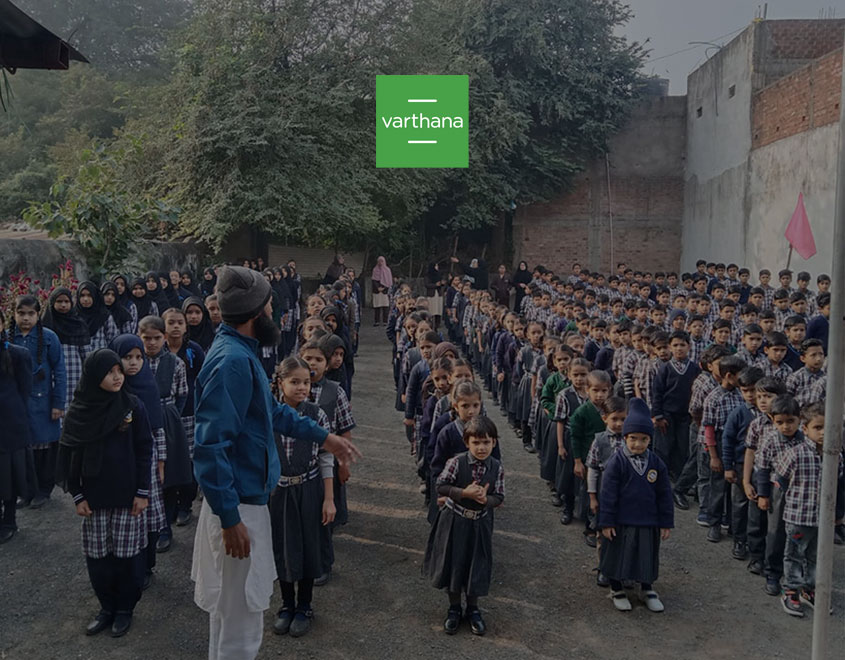
Is rural education in India facing challenges that often prevent students from realizing their full potential? Poor infrastructure, shortage of qualified teachers, outdated teaching methods, limited access to modern educational tools play a role in limiting students’ opportunities. These are some of the obstacles that rural schools must overcome. They not only affect learning outcomes but also limit the development of rural communities as a whole, thereby exacerbating poverty and inequality.
Education is a key milestone in rural development. Are individuals equipped with the skills and knowledge to improve their lives, sustain economic growth and drive social progress? According to the ASER report, India has an enrolment rate of over 95% for children aged between 3 and 16. However, concerns remain about the quality of education.
Vartana entered the game with a commitment to transforming rural education in India. Our mission is to bridge the education gap by providing financial support to semi-urban and rural schools. Our primary focus is on improving infrastructure, enhancing teacher quality and integrating technology. Through our financial services, we help schools build better facilities, purchase essential equipment and expand vocational training programs.
Our efforts aim to empower students, enhance learning outcomes, and create lasting social change. By prioritizing quality education, we are working to unlock the true potential of rural India and ensure a better future for our communities. Let’s dive in
Varthana’s Vision and Approach
Does Varthana envision a future where every student in rural India has access to quality education? Definitely! Varthana’s vision is to empower them to thrive in this ever-changing world. Its mission is to transform education by focusing on school infrastructure development, empowering teachers, promoting skill-based learning, and technology integration.
1. Infrastructure Development
- School Improvement Loans: You are the school owner and you are in need of support for building new classrooms, libraries, and laboratories for creating a better learning environment for students. Varthana provides the financial support that you require.
- Upgrade Facilities: Varthana even provides loans for upgrading existing facilities, including sanitation, drinking water, and electricity. This may be lacking in rural schools.
- Construction of New Schools: Varthana helps build new schools in areas where educational facilities are limited. This indirectly ensures that every child has access to quality education.
2. Teacher Empowerment Programs
Teachers are the backbone of education. Varthana is dedicated to enhancing their skills. Regular webinars and physical events introduce teachers to innovative teaching methods like activity-based learning and project-based assignments, making education more interactive and impactful.
3. Technology-Driven Learning
Varthana ensures students in rural areas are not left behind in gaining exposure to modern teaching methods. By supporting schools to integrate e-learning tools, tablets, and interactive digital content, we make learning more engaging and effective. Gamified content modules and interactive learning modules help students understand concepts faster and in a more fun way.
4. Skill-Focused Education
Varthana goes beyond academics and emphasizes the importance of life skills and vocational training, which prepares students to face real-world challenges. School Leader development programs and webinars are designed to nurture critical thinking, problem-solving, communication, and leadership abilities, ensuring holistic development.
5. Partnerships for Collective Impact
Collaboration is the cornerstone of Varthana’s approach. We work with ed-tech companies to bring cutting-edge tools to rural schools and partner with NGOs and government bodies to expand our reach. Varthana collaborates with organizations like Teach for India, Khan Academy, and government initiatives such as Digital India to bring the best resources to rural schools. These partnerships offer access to advanced technology, training resources, and funding opportunities, multiplying our impact.
Also Read: 7 reasons to create a business plan and budget for your school
Varthana’s Impact
Varthana has made a remarkable impact on rural education in India, empowering schools and students alike. We have supported more than 11,000 affordable private schools and 53,000 students across 19 states, helping them improve institutional infrastructure, technology integration and quality of education.
- There are 5,00,000 private schools in India, of which 60,000 are premium private schools, while 4,40,000 are affordable private schools. Varthana operates in the affordable private school segment and has supported close to 11,000 schools since its inception.
- The schools we cater to are mainly situated in semi-urban and rural areas that now boast better infrastructure, enhanced teaching quality, and more engaging classrooms.
- Our innovative initiatives have created a ripple effect, improving the quality of education in schools and transforming the lives of students and their communities.
- Our efforts have made a visible difference in ensuring that students from underprivileged backgrounds receive opportunities to thrive academically and socially.
Read More: Varthana Case Studies: Real-World Examples of How We Help School Businesses Thrive
Success Stories:
Varthana’s financial support enabled Sristi Global School in Bengaluru to expand from a preschool to a multi-campus institution. Thereby, increasing enrollment from 300 to over 3,000 students in a decade.
Woods Valley English Medium School in Raigarh, Chhattisgarh, faced financial difficulty in completing its building construction. With a loan from Varthana, they were able to finish the construction and accommodate more students. Read the full story here.
Mohammad Aslam Khan, school director of Ashta Public School in Madhya Pradesh, expressed how Varthana’s support helped the school overcome financial difficulties and continue to provide quality education, with students now going on to successful careers in fields such as engineering and healthcare.
Also Read: From A Farmerworker’s Son To Becoming A Proud Edupreneur
Quotes from Beneficiaries:
Hemant Kumar Sahu, Kanhaiya Lal Sahu Vedic Convent School of Janjgir Champa, Chhattisgarh says, “Our mission was clear — to bring higher education along with quality to the rural youth. It’s not just about education; it’s about sparking aspirations in every student we reach.” Read his full story here.
Mohammad Aslam Khan, Ashta Public School expresses, “Their support helped us keep providing quality education. Seeing my former students teaching beside me is one of the greatest rewards and happiness.”
Bridging the Digital Divide:
During the COVID-19 pandemic, Varthana went beyond financial support by providing academic resources such as worksheets, workbooks and digital content, especially for schools that have had difficulty transitioning to online learning. This effort played a key role in minimizing educational disruptions for rural students.
Also Read: Investing in Education: A Data-Driven Look at the Social Impact of School Construction Loans
Challenges and the Road Ahead
Varthana’s impact is significant, but there are a series of challenges to scaling up our work to reach more rural communities. Key obstacles include:
- Funding Constraints: Providing affordable loans to thousands of schools, especially in underserved areas, requires sustained funding. While Varthana has received substantial backing from investors and philanthropic bodies, securing consistent financial support for long-term growth remains a challenge, given the high demand for resources, especially in rural education.
- Infrastructure Gaps: Many rural areas still face basic infrastructure challenges, including unreliable internet access, inadequate classrooms, and a lack of proper sanitation. Varthana has been working to modernize its facilities, but overall closing these gaps is a complex and resource-consuming task.
- Teacher Training and Retention: One of Varthana’s main goals is to equip teachers with the skills to adopt new strategies. It can be difficult to retain well-trained teachers in rural areas due to limited career opportunities and low salaries. This issue impacts the sustainability of efforts to improve education standards at all levels.
- Adoption of Technology: While Varthana has been leading the way in integrating technology into schools, it faces challenges in adopting and sustaining digital tools, especially in areas with limited internet access and low digital literacy. This is an ongoing hurdle.
Expansion Plans
Despite these challenges, Varthana has ambitious plans to expand and reach more rural communities. Here’s how:
- Increasing Loan Contribution: Varthana aims to extend financial support to more schools so they can build better infrastructure and integrate technology in classrooms.
- Collaboration with Partners: Varthana plans to work with government agencies, nonprofits, and educators to scale its successful model and reach more schools.
- Increased Capital: Varthana is securing significant funding from investors. This inflow of capital will support its expansion plans and increase its capacity to serve the education sector.
- Innovative Programs: Varthana is committed to providing ideas to implement innovative teaching methods in the classrooms with the available resources through teacher certification programs, webinars, etc. that enhance the learning experience for students.
- Expanding Geographic Reach: Varthana aims to expand its services to rural communities and other states, especially the interior parts. Varthana plans to customize its programs to suit the specific needs of different parts of India.
- Teacher Support and Development: Recognizing the importance of quality teaching, we are committed to building sustainable teacher training programs and providing ongoing professional development to continually enhance teaching standards.
Conclusion
As Varthana expands its reach, our efforts have the potential to uplift communities through socio-economic development and sustainable progress. Our work is an indicator of the transformative power of education to help rural India thrive and contribute to the country’s overall growth. The journey is far from over, and Varthana’s mission relies on the continued support of individuals and organizations who share our vision of a more equitable future. You can find out more about our initiatives here.
FAQs
1. How education can be improved in rural areas?
- Schools should be easily accessible for everyone.
- Schools need to have good facilities, resources, well-trained teachers, and provide support to stay motivated to teach in rural areas.
- Technology like digital classes and online resources can bring quality education to rural areas.
- Scholarships, free mid-day meals, and transport can make it convenient for children to attend school regularly.
- Involving communities and parents in decisions and spreading awareness about the value of education.
2. What is the role of education in rural development?
It empowers individuals and communities with knowledge and skills to improve their quality of life. It helps farmers adopt modern agricultural techniques and increase productivity and income. It also creates awareness about health, hygiene, etc. reducing poverty and improving living standards. It opens up job opportunities enabling people to access better employment options than rural livelihood.
3. What is the government doing for rural development?
- Pradhan Mantri Gram Sadak Yojana (PMGSY) builds roads.
- Saubhagya Yojana provides electricity.
- Jal Jeevan Mission ensures access to clean drinking water.
- PM-KISAN provides financial assistance to farmers.
- Mahatma Gandhi National Rural Employment Guarantee Act (MGNREGA) provides job opportunities to rural households.
- National Rural Livelihood Mission (NRLM) encourages self-employment through skill development.
- Samagra Shiksha Abhiyan aims to improve rural education.
- Skill India Mission focuses on vocational training.
- Swachh Bharat Mission promotes sanitation and aims to make villages defecation-free.
- Ayushman Bharat ensures health insurance.
- Pradhan Mantri Awas Yojana (Gramin) provides affordable housing for rural families.
- Jan Dhan Yojana promotes financial inclusion.
- Ujjwala Yojana provides LPG connections.






Social